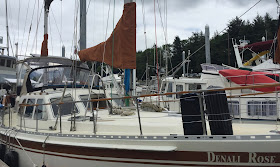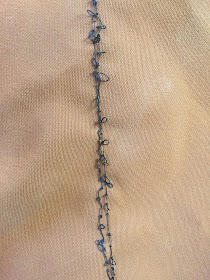 |
| I have a bruise on my forehead. |
The mainsail saga continues. (Part one here.) I didn't return to sewing until Sunday, and it was a day filled with angst. No matter what I did, I couldn't get the tension correct. I posted in the Facebook group, Sailrite Users, and asked for advice. I got everything from the simplistic, "adjust tension", (thanks buddy, I never would have thought of that....😒), to take the machine completely apart. What did I do?
I took the machine apart, well, not completely, but the bobbin assembly, and I took off the upper plate to see what the needle bar, and tension assembly were doing. I had previously purchased quite a few spare parts, and I replaced a couple of pieces that were worn. Sailrite has a video for just about everything, but the repair ones are not on their website, and you have to get them from opening a problem ticket, or in my case, from someone in the Facebook group. If you own a Sailrite, and have never seen these, here's a link to them.
Still, the machine refused to tension properly, and I sent in a trouble report via email to Sailrite Monday morning. I received several suggestions from them, and tried them all, tried them with different thread, tried them with different needles, tried them with alternating layers of material, tried to reroute tension, NOTHING worked. Now in addition to the tension mess, I couldn't sew more than 4 layers, or the webbing, without the thread breaking at the needle immediately.
 |
| Also adding a few expletive deleteds |
I don't even want to talk about the waste of thread. Profilen 4oz cone, 825yards sells at Sailrite for $75.95, and that's without the shipping to get it to Alaska.
 |
| My "sewing room" |
 |
| Profilen thread |
 |
| My practice scraps. |
I wrote a scathing email to Sailrite, listing the many tries for success, listing how much sewing I have done since I was 10years old, listing how many sewing machines I have ever used, it was cathartic. Before I sent it, (getting ahold of myself), I remembered someone had said, it's always the easy things that trip you up, so I got out the manual for the machine, and went over every detail of threading, tension, and needle placement. Guess what I found.... When I switched needles, I put the new one in backwards.
 |
| Palm to Face |
So, the fix was to replace the gib hook in the bobbin assembly, and use a larger needle to accommodate the Profilen thread. I adjusted the tension knob again, and TA DA, we're back to sewing again. All of this falderal lasted from Sunday to Wednesday, and I finished the webbing, and buckles Wednesday evening. Remember that hole I put in the canvas with the hot knife? It's under the webbing now, and no one knows, except you of course. I sewed like a fiend on Thursday, I was determined to get this project done. We had been using a strip of velcro in front of the mast for the front closure, and we wanted to add a zipper for security. It was lucky I had an extra zipper of approximately the correct length in my rubbermaid tub of tricks. I completed that, and then added our logo patch. It was time to put the cover in place. Bill helped with the parts I couldn't reach, and it was finished. Whew!
 |
| DONE! |
Oh yes, I did delete my scathing email to Sailrite, and replaced it with a thank-you for the great support they provide, also ordered a few more replacement parts, and extra needles.
If anyone would like a Denali Rose patch, just let me know, I had to buy a large amount in order to customize my patch. 😁
If anyone would like a Denali Rose patch, just let me know, I had to buy a large amount in order to customize my patch. 😁
As always, we enjoy hearing from you, either here in comments or on our Facebook Denali Rose Sailboat page.






























